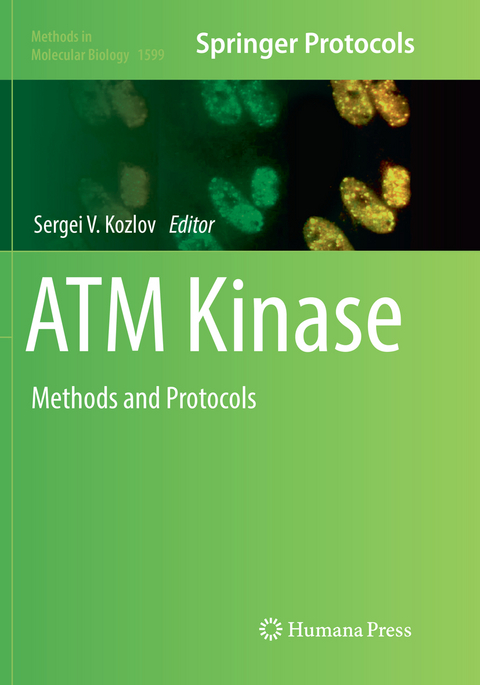
ATM Kinase
Humana Press Inc. (Verlag)
978-1-4939-8350-6 (ISBN)
Comprehensive and practical, ATM Kinase: Methods and Protocols aims to ignite and attract the interest of colleagues from diverse fields to A-T research in an effort to bring their expertise and fresh ideas to resolve many A-T puzzles still waiting to be pieced together and to alleviate the suffering of A-T children and their families.
Assaying Radiosensitivity of Ataxia-Telangiectasia.- Assaying for Radioresistant DNA Synthesis, the Hallmark Feature of the Intra-S-Phase Checkpoint Using a DNA Fiber Fluorography-Based Methodology.- ATM Gene Mutation Detection Techniques and Functional Analysis.- An HTRF® Assay for the Protein Kinase ATM.- ATM Kinase Inhibitors: HTS Cellular Imaging Assay Using CellomicsTM ArrayScan VTI Platform.- Image-Based High Content Screening: Automating the Quantification Process for DNA Damage-Induced Foci.- Analyzing ATM Function by Electroporation of Endonucleases and Immunofluorescence Microscopy.- Quantitative and Dynamic Imaging of ATM Kinase Activity by Bioluminescence Imaging.- Zn(II)–Phos-Tag SDS-PAGE for Separation and Detection of a DNA Damage-Related Signaling Large Phosphoprotein.- Identification of ATM Protein Kinase Phosphorylation Sites by Mass Spectrometry.- Studies of ATM Kinase Activity Using Engineered ATM Sensitive to ATP Analogues (ATM-AS).- Functional Characterization of ATM Kinase Using Acetylation-Specific Antibodies.- Identification of ATM-Interacting Proteins by Co-Immunoprecipitation and Glutathione-S-Transferase (GST) Pull-Down Assays.- ATM Activation and H2AX Phosphorylation Induced by Genotoxic Agents Assessed by Flow- and Laser Scanning-Cytometry.- Peptide Immunoaffinity Enrichment with Targeted Mass Spectrometry: Application to Quantification of ATM Kinase Phospho-Signaling.- Mass Spectrometry-Based Proteomics for Quantifying DNA Damage-Induced Phosphorylation.- Statistical Analysis of ATM-Dependent Signaling in Quantitative Mass Spectrometry Phosphoproteomics.- ChIP Technique to Study Protein Dynamics at Defined DNA Double-Strand Breaks.- Studies of the DNA Damage Response by Using the Lac Operator/Repressor (LacO/LacR) Tethering System.- Imaging of Fluorescently-Tagged ATM Kinase at the Sites of DNA Double-Strand Breaks.- Live Cell Imaging to Study Real-Time ATM-Mediated Recruitment of DNA Repair Complexes to Sites of Ionizing Radiation-Induced DNA Damage.- Analyzing Heterochromatic DNA Double Strand Break (DSB) Repair in Response to Ionizing Radiation.- Phenotypic Analysis of ATM Protein Kinase in DNA Double-Strand Break Formation and Repair.- Monitoring DNA Repair Consequences of ATM Signaling Using Simultaneous Fluorescent Readouts.- Non-Canonical ATM Activation and Signaling in Response to Transcription-Blocking DNA Damage.- Study of ATM Phosphorylation by Cdk5 in Neuronal Cells.- DNA Damage Response in Human Stem Cells and Neural Descendants.- A Patient-Specific Stem Cell Model to Investigate the Neurological Phenotype Observed in Ataxia-Telangiectasia.- Lentiviral Reprogramming of A-T Patient Fibroblasts to Induced Pluripotent Stem Cells.- Monitoring the ATM-Mediated DNA Damage Response in the Cerebellum Using Organotypic Cultures.
| Erscheinungsdatum | 18.08.2018 |
|---|---|
| Reihe/Serie | Methods in Molecular Biology ; 1599 |
| Zusatzinfo | 69 Illustrations, color; 24 Illustrations, black and white; XIV, 437 p. 93 illus., 69 illus. in color. |
| Verlagsort | Totowa, NJ |
| Sprache | englisch |
| Maße | 178 x 254 mm |
| Themenwelt | Medizin / Pharmazie ► Medizinische Fachgebiete |
| Studium ► 2. Studienabschnitt (Klinik) ► Humangenetik | |
| Schlagworte | Ataxia–telangiectasia (A-T) • ATM gene • DNA Damage • Genetic disorder • Mutated |
| ISBN-10 | 1-4939-8350-4 / 1493983504 |
| ISBN-13 | 978-1-4939-8350-6 / 9781493983506 |
| Zustand | Neuware |
| Informationen gemäß Produktsicherheitsverordnung (GPSR) | |
| Haben Sie eine Frage zum Produkt? |
aus dem Bereich


